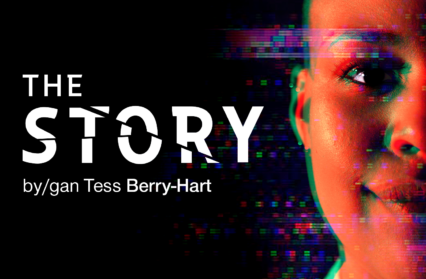Georgia Winstone-Cooper reviews The Story, Tess Berry-Hart’s contribution to The Other Room’s Violence season.

Based upon the experiences and observations of playwright Tess Berry-Hart during her time working with refugees fleeing Syria and Libya, The Story explores the psychological effects of interrogation and questions whether mental torture is worse than physical. Beginning with a friendly chat and descending into an interrogation style which provides no more explanation to the audience than to the prisoner – known only as Prisoner X – the simple set and a cast of only two highlights the intense power plays and manipulation of such torture.
The actualised actions of physical and mental abuse are vastly different, yet both aim to disorientate and remove the sense of identity and worth of a human being from their understanding of their own personhood. The Story focuses on the experience of one woman as she attempts to return home from volunteering in a refugee camp, only to discover she has been deemed an enemy of the people and is herself no longer considered a person. The intensity of the interrogation is intermittently alleviated as the two cast members (Siwan Morris and Hannah McPake) exit the stage to change characters and clothes or begin a new scene, the tense atmosphere – excellently created by a well-crafted script and superb delivery – is broken by videos displayed upon several block screens surrounding the stage. Whilst these videos remind the audience of a world outside the interrogation room, they often diminish the effect of the production, rather than add to it. The layout of the block walls onto which the videos are projected alternate and obscure the face of the spokesperson of the people/government in such a way that no matter where the audience looks, a different perspective is shown. This aspect of the videos adds to the overall disturbing nature of the play, yet the dream sequence, as is common with the trope, is close to entering the realm of cliché which is the sole artistic drawback of an otherwise excellent production.
The Story is not situated within any particular time period or place and whilst inspired by real-life events, does not base itself on historic reality. Instead, The Story depicts a futuristic dystopia in which a fascist government has taken power in Wales and brings the refugee crisis currently gripping Europe even closer to home. The recent refugee crisis has been creating a hellish existence for thousands of people for many years and The Story highlights just one small aspect of the horrors experienced by all those involved, even those who attempt to help. Despite its well-intentioned attempts to draw attention to victims of war and hard borders, the decision to focus almost entirely upon the plight of a volunteer aiding a revolution is questionable. Although the plot makes no reference to the real refugee crisis, the fact that it is based upon the experiences of imprisoned Libyan and Syrian refugees raises the question of why these traumas were supplanted into the life of a white Welsh woman. War can make any person a refugee, yet the inspiration for The Story, and the victims of the refugee crisis, are primarily non-white and reported by sensationalist media outlets as predominately Muslim; a depiction that relegates them to the status of the ‘other’. The dystopian government of The Story echoes the rhetoric of the far-right in their depictions of the refugees currently residing throughout Britain and the European continent, focusing especially on the language used by politicians regarding Brexit. Phrases such as “enemy of the people” and the accusation of interfering with the “democratic will of the people” are used continuously and are reminiscent of Brexit debates, during which issues of immigration and refugee status have been the primary focus.
Tess Berry-Hart’s script incorporates issues surrounding Brexit, the perception of refugees, racism, xenophobia, and the horrific treatment of people in Syrian and Libyan prisoners without ever relaying any truth about these situations. The Story, in the end, does not deep enough. Prisoner X is informed that refugees are considered to be non-persons, for example, and the production had the opportunity to explore this further and truly delve into the effects of denying someone refuge from war; however, it merely touches upon the issue and then pulls away. Whilst these snippets of information fed to Prisoner X heightens the audience’s perception of the confusion felt by the prisoner, they do so at the expense of a play which could have truly interrogated the causes and effects of the current refugee crisis. As a play solely exploring psychological torture and the victims of war, The Story is a success. But as one which seeks to relay the truth of how real people are currently being treated, it sadly falls short.
The Story by Tess Berry-Hart is on at The Other Room in Cardiff until October 27th.
Georgia Winstone-Cooper is a regular contributor to Wales Arts Review.


 Enjoyed this article? Support our writers directly by buying them a coffee and clicking this link.
Enjoyed this article? Support our writers directly by buying them a coffee and clicking this link.








